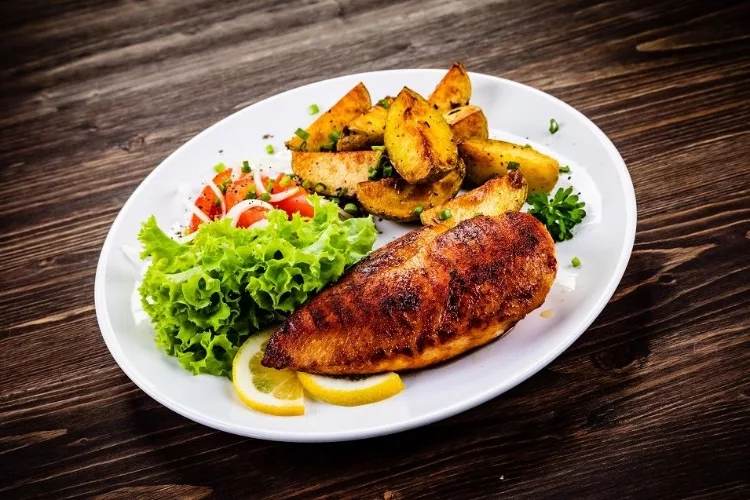by Rick Goldman
Chicken is the staple food for the majority of non-vegetarians around the world. It's a supple and tender supply of protein that anybody can hardly refuse. There is no lack in the variety of recipes to cook chicken. It's the most versatile form of fowl as they have recipes designated for each of its parts.
Accordingly, chicken breast is one of the most tender and juicy slices of meat that can induce enchanting temptation if cooked correctly. If you are an expert at cooking chicken breasts, it will certainly leave your guests asking for more.
Contents
Sometimes the meal is so good that you decide to save it for another day, but is it safe to reheat a 24-hour refrigerated chicken breast? Fortunately, it is if cooked with specific guidelines in mind. Here are some ways you can rejuvenate the tender piece of meat without worrying about contamination.

The first thing you need to keep in mind is that this particular piece of meat is prone to drying out quickly, especially when you're trying to reheat it. You need to make sure it doesn't lose its moisture or freshness in any way.
If your chicken breast recipe doesn't include removing the skin, it's recommended to use a non-stick pan for this method. Place the pan on the stove, and set it on low or medium heat. You need to ensure that you don't heat it for too long before placing the leftover chicken breast on it as it might leave you with under-cooked meat.
To make sure the meat doesn't lose its moisture, pour about 15 milliliters of cooking oil or butter on the stove. Water or chicken broth is also a suitable substitute for this method. Next, place the leftover chicken on the pan using a tong. Place the pieces one by one, and try to avoid overcrowding the pan.
Make sure you cook the meat through and through by shifting their positions from time to time. Keep an eye on them and turn them around so the meat gets evenly cooked on both sides.
Don't leave the chicken on the stove for too long. Some pieces might be ready earlier than the others, so try not to overcook them. When you notice a brownish hue on your chicken breast, it's ready to be taken out. Take it out and place it on a plate, and let the juices settle for a while.
It is preferred to cut the chicken into smaller pieces in this method. Doing so will decrease the chances of overcooking the breast meat. Once cut, place the pieces on a plate safe for microwaving but don't overcrowd it. Leave spaces between them to make sure it heats uniformly.
That's because overlapping the pieces might not distribute the heat evenly between them. Likewise, before placing it in the microwave, slather the slices with about 15 milliliters of chicken broth to keep them moisturized.
Additionally, place a damp cloth on top of it so that the chicken can retain its moisture. This will prevent them from drying out easily. It's prohibited to use any plastic materials to cover them as it can melt, and contaminate your dish.
Next, place the plate of chicken breasts inside the microwave. If you're heating a generous serving of chicken, set the microwave to 3 minutes to begin with. If it's a smaller serving, leave it for 1.5 minutes at first. Settings must be kept normal at 1000 watts to prevent overheating.
Check the meat in between the time limits, and flip the pieces to heat them evenly. Use your fingers or a little taste test to check if the chicken has been cooked through. Keep checking in 30-second intervals until it reaches the desired temperature.
Take the plate of chicken out of the microwave carefully using oven mitts when done. Don't take the lid off right away. Let it rest for a while, and let the juices settle. Be careful when removing the lid as it might emanate scalding hot steam on your face and hands. After a couple of minutes, your chicken breast will be ready to be served.
If you have previously stored the chicken in the freezer, the first step is defrosting it. Don't cook a frozen chicken right away. You can either gradually defrost the chicken by placing it in the refrigerator for about six hours or, you can do it faster in the microwave using the defrost setting.
Don't forget to cut the chicken into smaller pieces after defrosting it. This will prevent the breast meat from drying out, and help with heating it evenly. In the same manner, spread the pieces of chicken on a plate to maintain an equal distribution of heat between them.
You can wrap the top of the plate shut to make sure they don't lose their moisture. Use aluminum foil or a lid to seal it closed. Don't forget to pour leftover chicken broth over the chicken pieces before doing so.
At the same time, before placing the plate of meat inside the oven, make sure it's heated up to 218 to 246 degree Celsius. This is the ideal temperature for reheating the chicken. Wait as long as it takes for your oven to reach that temperature; then place the leftover meat inside the oven. Reheat it at a temperature of 74 degree Celsius.
As you have cut the chicken into smaller pieces, it won't take long for the chicken to be heated to its desired temperature. Check the temperature in the insides of the meat using a meat thermometer to ensure that the chicken is heated through and through. Similarly, slather the pieces with chicken broth again if you notice it drying out.
Afterward, carefully take out the chicken using oven mitts to protect your hand. Place the pot on the counter, and serve the chicken. Try to keep yourself or your guests from digging in instantly. Let the juices settle for two minutes. You don't want a dry piece of chicken breast to ruin your day.
Chicken breast is an exotic yet sensitive piece of chicken. Reheating it can often be tricky due to how easily it's vulnerable to drying up. If you follow the instructions above wisely, you won't end up tarnishing the meat.
Always remember to moisturize it with chicken broth or leftover juices from the pan, and also let the juices distribute evenly after heating. This will replenish your favorite meal for a second serving.
On the other hand, beware when handling hot food, and use all the necessary safety precautions. Even the most luscious piece of chicken isn't worth burning your hand over!
 |
 |
 |
 |
 |
 |
 |
 |

About Rick Goldman
Rick Goldman's grandpa was a captain of a California coast cruise. This afforded Rick the luxury of traveling to exciting places along the Pacific Coast as a young boy. He got to try different, exotic foods on these journeys - something he really enjoys blogging about from his grandpa's beautiful garden home today.
Kitchen Goodness
Check for FREE Gifts. Or get our Free Cookbooks right now.
Disable the Ad Block to reveal all the recipes. Once done that, click on any button below
 |
 |
 |
 |